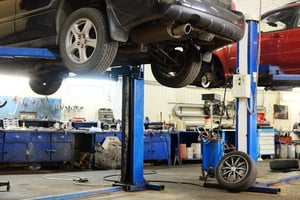Handling Auto Shop Customer Disputes
 Complaints and comebacks certainly mean more work for your auto shop, but sometimes that work comes complete with an upset customer. While much of your shop's business happens in the garage and out of the public eye, your face to face interactions with customers makes impressions that can win and lose future jobs. Thankfully, by practicing some basic customer service principles, you can prep your team for turning negative customer experiences into positive ones. In this post, we'll explain the best practices for handling auto shop customer disputes that apply to a wide range of complaints, from prices to workmanship and more.
Complaints and comebacks certainly mean more work for your auto shop, but sometimes that work comes complete with an upset customer. While much of your shop's business happens in the garage and out of the public eye, your face to face interactions with customers makes impressions that can win and lose future jobs. Thankfully, by practicing some basic customer service principles, you can prep your team for turning negative customer experiences into positive ones. In this post, we'll explain the best practices for handling auto shop customer disputes that apply to a wide range of complaints, from prices to workmanship and more.
How to Handle Auto Shop Customer Complaints
Both before and after service has been completed, you and your team may be forced to deal with customers experiencing negative emotions or results. While these customers can be tricky to communicate with, here is a list of techniques to help you reassure your customer and agree on a solution that pleases you both.
 Don't take it personally or get emotional. When your customer is having an emotional reaction to their situation, whether it be a symptom of their vehicle's issue or a problem with the service they've received, it's important to remember that you, personally, are not the issue at hand. By remaining calm, cool, and collected on the other side of this interaction, you can stay in control of the situation without escalating it further. Do your best to look at the situation objectively, despite the emotional response surrounding the information.
Don't take it personally or get emotional. When your customer is having an emotional reaction to their situation, whether it be a symptom of their vehicle's issue or a problem with the service they've received, it's important to remember that you, personally, are not the issue at hand. By remaining calm, cool, and collected on the other side of this interaction, you can stay in control of the situation without escalating it further. Do your best to look at the situation objectively, despite the emotional response surrounding the information.- Listen carefully and actively. It may take a little time, but another best practice is to let your customer express everything they're struggling with first before interrupting or explaining. First, in order to provide a solution, you'll need to collect as much information from your customer as possible. Second, actively listening to your customer helps them feel like their concerns matter to you and your business and shows that you're devoted to resolving the issue(s).
 Ask and answer questions. Your interaction with every customer should then transition to an open dialogue. You should ask any questions that the customer hasn't already covered in their explanations, as well as offer to answer any specific questions they have for you. This give and take approach can often resolve any misunderstanding that's causing the customer's dispute without much effort at all. In other cases, it can also allow you and your customer to arrive at a solution together by the end of the conversation. When customers feel like they've been included in a decision, the resulting solution is generally perceived as much more fair and trustworthy.
Ask and answer questions. Your interaction with every customer should then transition to an open dialogue. You should ask any questions that the customer hasn't already covered in their explanations, as well as offer to answer any specific questions they have for you. This give and take approach can often resolve any misunderstanding that's causing the customer's dispute without much effort at all. In other cases, it can also allow you and your customer to arrive at a solution together by the end of the conversation. When customers feel like they've been included in a decision, the resulting solution is generally perceived as much more fair and trustworthy.- Be honest, but explain what's happening in language your customer can understand. Finally, you should strive to be as honest as possible with your customer in addressing their concerns about their vehicle or your service. However, using technical terms and jargon can cause customers to feel like you're intentionally trying to confuse them with your language. Instead of relying on technical language, do your best to explain each step of your service or solution using layman's terms that would make sense to the average consumer, not just to another technician. By communicating on a common level of understanding, your customer can understand the steps you're taking to address their problem.
Improving Your Shop's Customer Experience
By practicing patience and communication skills in your auto shop, you're already well on your way to resolving any customer's dispute or problem from the very beginning of your conversation. However, if you find yourself addressing the same issues over and over again, it may be time to examine your shop process and policies to see if there's room for improvement. By taking the time to log these concerns and figure out their common roots, you'll likely discover areas in your business and service processes that can be optimized for a better customer experience overall, now and in the future. Addressing these concerns might take some time and investment in training, technology, or strategy, but in the end, a positive customer experience is always worth it. When one of the best sources of positive marketing for your shop is word of mouth in your community, ensuring that every customer is satisfied with your service should be one of your shop's top priorities.


